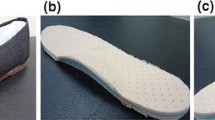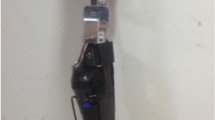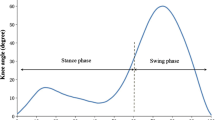Abstract
Patients with knee osteoarthritis (KOA) usually experience pain in the medial compartment of their knee which accompany varus postures. This causes much larger lateral-side foot pressure than that of the medial side which may lead to functional limitation in their daily life. Reducing knee loading during gait could help patients with KOA alleviate pain and improve walking functions. In this study, a prototype for a new pneumatic knee orthosis (PKO) is developed to support the knee by increasing the pneumatic pressure of the PKO during the stance period of walking using foot pressure feedback in real time. Force-sensing resistor sensors in the PKO were used to detect the gait phase and monitor the foot pressures in real time. To investigate the feasibility of the system, walking tests on a treadmill were performed at 2 km/h and 3 km/h by healthy subjects. The results show that the developed PKO can reduce lateral-side foot pressure during stance phase. The PKO in this study could be used as a research tool to investigate the relationship between foot pressure and knee loading as well as therapeutic purposes to reduce medial compartment loading in the knee.








Similar content being viewed by others
References
Englund, M. (2010). The role of biomechanics in the initiation and progression of OA of the knee. Best Practice and Research in Clinical Rheumatology, 24(1), 39–46. https://doi.org/10.1016/j.berh.2009.08.008.
Hunter, D. J., & Wilson, D. R. (2009). Role of alignment and biomechanics in osteoarthritis and implications for imaging. Radiologic Clinics of North America, 47(4), 553. https://doi.org/10.1016/j.rcl.2009.04.006.
Kim, I., Kim, H. A., Seo, Y. I., Song, Y. W., Jeong, J. Y., & Kim, D. H. (2010). The prevalence of knee osteoarthritis in elderly community residents in Korea. Journal of Korean Medical Science, 25(2), 293–298. https://doi.org/10.3346/jkms.2010.25.2.293.
Helmick, C. G., Felson, D. T., Lawrence, R. C., Gabriel, S., Hirsch, R., Kwoh, C. K., et al. (2008). Estimates of the prevalence of arthritis and other rheumatic conditions in the United States. Arthritis and Rheumatism, 58(1), 15–25. https://doi.org/10.1002/art.23177.
Dowling, A. V., Fisher, D. S., & Andriacchi, T. P. (2010). Gait modification via verbal instruction and an active feedback system to reduce peak knee adduction moment. Journal of Biomechanical Engineering-Transactions of the ASME. https://doi.org/10.1115/1.4001584.
Wallace, I. J., Worthington, S., Felson, D. T., Jurmain, R. D., Wren, K. T., Maijanen, H., et al. (2017). Knee osteoarthritis has doubled in prevalence since the mid-20th century. Proceedings of the National Academy of Sciences of the United States of America, 114(35), 9332–9336. https://doi.org/10.1073/pnas.1703856114.
Farrokhi, S., Voycheck, C. A., Tashman, S., & Fitzgerald, G. K. (2013). A biomechanical perspective on physical therapy management of knee osteoarthritis. Journal of Orthopaedic and Sports Physical Therapy, 43(9), 600–619. https://doi.org/10.2519/jospt.2013.4121.
Maly, M. R., Culham, E. G., & Costigan, P. A. (2002). Static and dynamic biomechanics of foot orthoses in people with medial compartment knee osteoarthritis. Clinical Biomechanics, 17(8), 603–610. https://doi.org/10.1016/S0268-0033(02)00073-6.
Baliunas, A. J., Hurwitz, D. E., Ryals, A. B., Karrar, A., Case, J. P., Block, J. A., et al. (2002). Increased knee joint loads during walking are present in subjects with knee osteoarthritis. Osteoarthritis and Cartilage, 10(7), 573–579. https://doi.org/10.1053/joca.2002.0797.
Hurwitz, D. E., Ryals, A. B., Case, J. P., Block, J. A., & Andriacchi, T. P. (2002). The knee adduction moment during gait in subjects with knee osteoarthritis is more closely correlated with static alignment than radiographic disease severity, toe out angle and pain. Journal of Orthopaedic Research, 20(1), 101–107. https://doi.org/10.1016/S0736-0266(01)00081-X.
Rutherford, D. J., Hubley-Kozey, C. L., Deluzio, K. J., Stanish, W. D., & Dunbar, M. (2008). Foot progression angle and the knee adduction moment: a cross-sectional investigation in knee osteoarthritis. Osteoarthritis and Cartilage, 16(8), 883–889. https://doi.org/10.1016/j.joca.2007.11.012.
Rosland, T., Gregersen, L. S., Eskehave, T. N., Kersting, U. G., & Arendt-Nielsen, L. (2015). Pain sensitization and degenerative changes are associated with aberrant plantar loading in patients with painful knee osteoarthritis. Scandinavian Journal of Rheumatology, 44(1), 61–69. https://doi.org/10.3109/03009742.2014.923038.
Jung, Y., Koo, Y. J., & Koo, S. (2017). Simultaneous estimation of ground reaction force and knee contact force during walking and squatting. International Journal of Precision Engineering and Manufacturing, 18(9), 1263–1268. https://doi.org/10.1007/s12541-017-0148-7.
Wheeler, J. W., Shull, P. B., & Besier, T. F. (2011). Real-time knee adduction moment feedback for gait retraining through visual and tactile displays. Journal of Biomechanical Engineering-Transactions of the ASME. https://doi.org/10.1115/1.4003621.
Gaasbeek, R. D. A., Groen, B. E., Hampsink, B., van Heerwaarden, R. J., & Duysens, J. (2007). Valgus bracing in patients with medial compartment osteoarthritis of the knee: A gait analysis study of a new brace. Gait and Posture, 26(1), 3–10. https://doi.org/10.1016/j.gaitpost.2006.07.007.
Lindenfeld, T. N., Hewett, T. E., & Andriacchi, T. P. (1997). Joint loading with valgus bracing in patients with varus gonarthrosis. Clinical Orthopaedics and Related Research, 344, 290–297.
Self, B. P., Greenwald, R. M., & Pflaster, D. S. (2000). A biomechanical analysis of a medial unloading brace for osteoarthritis in the knee. Arthritis Care and Research, 13(4), 191–197. https://doi.org/10.1002/1529-0131(200008)13:4<191:Aid-Anr3>3.0.Co;2-C.
Kapadia, B. H., Cherian, J. J., Starr, R., Chughtai, M., Mont, M. A., Harwin, S. F., et al. (2016). Gait using pneumatic brace for end-stage knee osteoarthritis. Journal of Knee Surgery, 29(3), 218–223. https://doi.org/10.1055/s-0036-1579790.
Brouwer, R. W., van Raaij, T. M., Verhaar, J. A. N., Coene, L. N. J. E. M., & Bierma-Zeinstra, S. M. A. (2006). Brace treatment for osteoarthritis of the knee: a prospective randomized multi-centre trial. Osteoarthritis and Cartilage, 14(8), 777–783. https://doi.org/10.1016/j.joca.2006.02.004.
Sawicki, G. S., & Ferris, D. P. (2009). A pneumatically powered knee-ankle-foot orthosis (KAFO) with myoelectric activation and inhibition. Journal of Neuroengineering and Rehabilitation. https://doi.org/10.1186/1743-0003-6-23.
Ba, D. X., & Ahn, K. K. (2018). A robust time-delay nonlinear controller for a pneumatic artificial muscle. International Journal of Precision Engineering and Manufacturing, 19(1), 23–30. https://doi.org/10.1007/s12541-018-0003-5.
Preece, S. J., Jones, R. K., Brown, C. A., Cacciatore, T. W., & Jones, A. K. P. (2016). Reductions in co-contraction following neuromuscular re-education in people with knee osteoarthritis. BMC Musculoskeletal Disorders. https://doi.org/10.1186/s12891-016-1209-2.
Acknowledgements
This work was supported by the National Research Council of Science & Technology (NST) grant funded by the Korea government (MSIT) (No. CAP-18-01-KIST), a Korea University Grant and by the Intramural Program (Project No. K1804361) of Korea University.
Author information
Authors and Affiliations
Corresponding author
Ethics declarations
Conflict of interest
None.
Ethics Approval
KIST Institutional Review Board (KIST IRB 2017-002).
Additional information
Publisher's Note
Springer Nature remains neutral with regard to jurisdictional claims in published maps and institutional affiliations.
Rights and permissions
About this article
Cite this article
Kim, J., Moon, H.S., Lee, S.J. et al. Foot Pressure Feedback Pneumatic Orthosis: Implication of Daily Life Walking Training for Knee Osteoarthritis Patients. Int. J. Precis. Eng. Manuf. 21, 2191–2198 (2020). https://doi.org/10.1007/s12541-020-00397-7
Received:
Revised:
Accepted:
Published:
Issue Date:
DOI: https://doi.org/10.1007/s12541-020-00397-7




